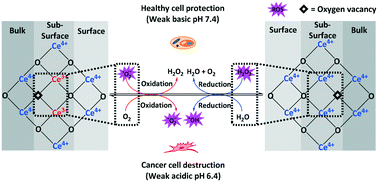当前位置:
X-MOL 学术
›
CrystEngComm
›
论文详情
Our official English website, www.x-mol.net, welcomes your feedback! (Note: you will need to create a separate account there.)
Engineering oxygen vacancies through construction of morphology maps for bio-responsive nanoceria for osteosarcoma therapy†
CrystEngComm ( IF 3.1 ) Pub Date : 2018-02-12 00:00:00 , DOI: 10.1039/c8ce00001h Rashid Mehmood 1, 2, 3, 4 , Xiaochun Wang 5, 6, 7, 8, 9 , Pramod Koshy 1, 2, 3, 4 , Jia Lin Yang 5, 6, 7, 8, 9 , Charles C. Sorrell 1, 2, 3, 4
CrystEngComm ( IF 3.1 ) Pub Date : 2018-02-12 00:00:00 , DOI: 10.1039/c8ce00001h Rashid Mehmood 1, 2, 3, 4 , Xiaochun Wang 5, 6, 7, 8, 9 , Pramod Koshy 1, 2, 3, 4 , Jia Lin Yang 5, 6, 7, 8, 9 , Charles C. Sorrell 1, 2, 3, 4
Affiliation

|
The present work provides guidelines for the engineering of oxygen vacancy concentrations using morphology-maps based on the characteristics of nanoceria (CeO2−x) nanocubes, nanorods, and truncated nanooctahedra. These were characterised by XRD, TEM, BET, DLS, and XPS. The morphology maps reveal that the redox performance, particle size, and surface roughness (apparent porosity) can be optimised by engineering the oxygen vacancy concentrations, but the morphology is dominated by the reaction temperature. However, the oxygen vacancy concentration is controlled by the concentration of the NaOH precipitant/oxidant. These vacancies can be potentially located at the surface, subsurface, and bulk regions, but the subsurface vacancies provide the principal redox activity. The biological effects of nanoceria in terms of oxygen vacancies were analysed in normal and cancer cells. Nanoceria particles exhibit antioxidant and cytoprotective effects at physiological pH 7.4 but prooxidant and cytotoxic effects at tumour microenvironment pH 6.4. The relative redox performances and cytotoxicities are in the order nanocubes < nanorods < truncated nanooctahedra, which is a direct reflection of the relative oxygen vacancy concentrations. The redox performance of nanoceria has been contextualised by cellular uptake and its quantification in osteosarcoma cells.
中文翻译:

通过构建用于骨肉瘤治疗的生物反应性纳米氧化铈的形态图来工程化氧空位†
本工作为基于纳米氧化铈(CeO 2− x)纳米立方体,纳米棒和截短的纳米八面体。这些通过XRD,TEM,BET,DLS和XPS表征。形态图表明,可以通过设计氧空位浓度来优化氧化还原性能,粒度和表面粗糙度(表观孔隙率),但形态主要受反应温度的影响。然而,氧空位浓度由NaOH沉淀剂/氧化剂的浓度控制。这些空位可能位于表面,地下和主体区域,但是地下空位提供了主要的氧化还原活性。在正常和癌细胞中分析了纳米氧化铈在氧空位方面的生物学效应。纳米氧化铈颗粒在生理pH值为7时具有抗氧化和细胞保护作用。4但在肿瘤微环境pH 6.4下有抗氧化剂和细胞毒性作用。相对氧化还原性能和细胞毒性的顺序为:纳米立方体<纳米棒<截短的纳米八面体,这直接反映了相对的氧空位浓度。纳米氧化铈的氧化还原性能已通过细胞摄取及其在骨肉瘤细胞中的定量来确定。
更新日期:2018-02-12
中文翻译:

通过构建用于骨肉瘤治疗的生物反应性纳米氧化铈的形态图来工程化氧空位†
本工作为基于纳米氧化铈(CeO 2− x)纳米立方体,纳米棒和截短的纳米八面体。这些通过XRD,TEM,BET,DLS和XPS表征。形态图表明,可以通过设计氧空位浓度来优化氧化还原性能,粒度和表面粗糙度(表观孔隙率),但形态主要受反应温度的影响。然而,氧空位浓度由NaOH沉淀剂/氧化剂的浓度控制。这些空位可能位于表面,地下和主体区域,但是地下空位提供了主要的氧化还原活性。在正常和癌细胞中分析了纳米氧化铈在氧空位方面的生物学效应。纳米氧化铈颗粒在生理pH值为7时具有抗氧化和细胞保护作用。4但在肿瘤微环境pH 6.4下有抗氧化剂和细胞毒性作用。相对氧化还原性能和细胞毒性的顺序为:纳米立方体<纳米棒<截短的纳米八面体,这直接反映了相对的氧空位浓度。纳米氧化铈的氧化还原性能已通过细胞摄取及其在骨肉瘤细胞中的定量来确定。



























 京公网安备 11010802027423号
京公网安备 11010802027423号